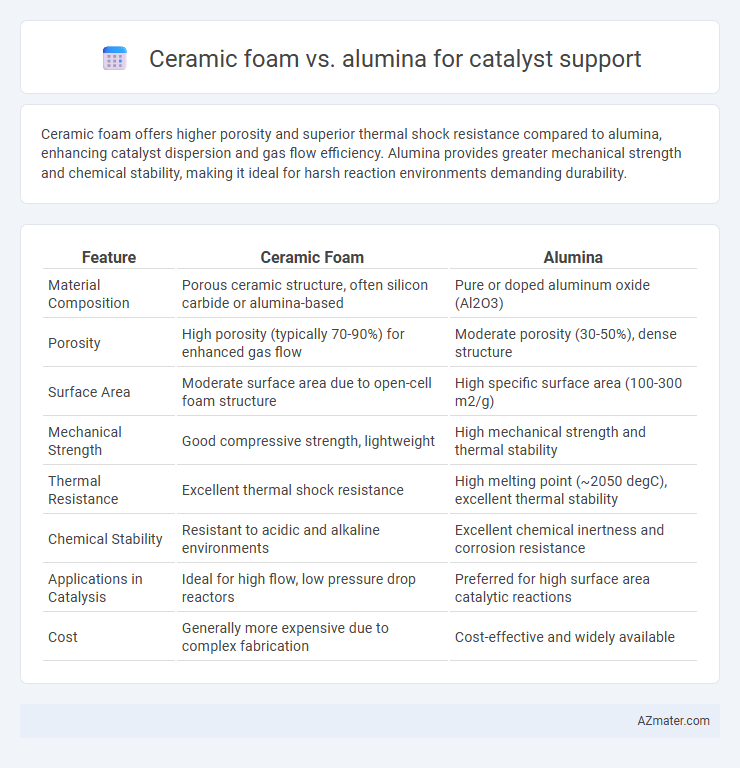Ceramic foam offers higher porosity and superior thermal shock resistance compared to alumina, enhancing catalyst dispersion and gas flow efficiency. Alumina provides greater mechanical strength and chemical stability, making it ideal for harsh reaction environments demanding durability.
Table of Comparison
| Feature | Ceramic Foam | Alumina |
|---|---|---|
| Material Composition | Porous ceramic structure, often silicon carbide or alumina-based | Pure or doped aluminum oxide (Al2O3) |
| Porosity | High porosity (typically 70-90%) for enhanced gas flow | Moderate porosity (30-50%), dense structure |
| Surface Area | Moderate surface area due to open-cell foam structure | High specific surface area (100-300 m2/g) |
| Mechanical Strength | Good compressive strength, lightweight | High mechanical strength and thermal stability |
| Thermal Resistance | Excellent thermal shock resistance | High melting point (~2050 degC), excellent thermal stability |
| Chemical Stability | Resistant to acidic and alkaline environments | Excellent chemical inertness and corrosion resistance |
| Applications in Catalysis | Ideal for high flow, low pressure drop reactors | Preferred for high surface area catalytic reactions |
| Cost | Generally more expensive due to complex fabrication | Cost-effective and widely available |
Introduction to Catalyst Support Materials
Catalyst support materials like ceramic foam and alumina play a crucial role in enhancing catalyst performance by providing a high surface area and structural stability. Ceramic foam offers superior thermal conductivity and mechanical strength, making it ideal for high-temperature applications, while alumina is widely valued for its high surface area, chemical inertness, and excellent adsorption properties. Selecting between ceramic foam and alumina depends on factors such as reaction environment, thermal management needs, and catalyst dispersion requirements.
Overview of Ceramic Foam Supports
Ceramic foam supports, commonly made from materials like alumina, offer a high surface area and excellent thermal stability crucial for catalyst performance. Their porous structure enhances fluid flow and mass transfer while minimizing pressure drop, making them ideal for catalytic reactions in industries such as automotive and petrochemical. Compared to traditional alumina pellets, ceramic foam supports provide improved mechanical strength and durability under harsh operating conditions.
Alumina as a Catalyst Support: Key Properties
Alumina is a widely used catalyst support due to its high surface area, thermal stability, and strong mechanical strength, which enhance catalyst dispersion and longevity. Its porosity and acidic properties facilitate effective reactant adsorption and facilitate catalytic reactions in processes like hydrocracking and reforming. Compared to ceramic foam, alumina offers superior chemical inertness and tailored surface chemistry, making it ideal for diverse catalytic applications.
Structural Differences: Ceramic Foam vs Alumina
Ceramic foam exhibits a highly porous, three-dimensional interconnected network with larger pore sizes, enabling enhanced gas flow and mass transfer compared to alumina, which typically has a dense, granular microstructure with smaller pores. The open-cell structure of ceramic foam provides superior mechanical strength and thermal shock resistance, while alumina's high surface area and chemical stability contribute to effective catalytic activity. These structural differences influence catalyst support performance, with ceramic foam being favored for processes requiring rapid heat exchange and flow dynamics, whereas alumina excels in reactions benefiting from high surface adsorption.
Surface Area and Porosity Comparison
Ceramic foam typically offers higher porosity, often exceeding 90%, which enhances catalyst distribution and fluid flow compared to alumina supports that generally have lower porosity around 30-40%. Alumina provides a significantly greater specific surface area, ranging from 100 to 300 m2/g, crucial for catalytic reactions, whereas ceramic foam's surface area is comparatively lower, commonly below 50 m2/g. The choice between ceramic foam and alumina depends on balancing higher porosity for mass transfer efficiency against higher surface area for catalytic activity.
Thermal Stability and Resistance
Ceramic foam catalyst supports exhibit superior thermal stability due to their highly porous structure, allowing efficient heat dissipation and resistance to thermal shock. Alumina, while widely used for its excellent mechanical strength and chemical inertness, may suffer from sintering at elevated temperatures, reducing surface area and catalytic performance. Ceramic foam materials maintain structural integrity and resist thermal degradation better than alumina under harsh reaction conditions, enhancing catalyst longevity and efficiency.
Chemical Compatibility and Reactivity
Ceramic foam and alumina differ significantly in chemical compatibility and reactivity when used as catalyst supports. Ceramic foam offers superior corrosion resistance and stability in harsh chemical environments due to its inert composition, minimizing unwanted reactions during catalytic processes. Alumina, while providing high surface area and mechanical strength, may exhibit higher reactivity with acidic or basic reactants, potentially affecting catalyst performance and lifespan.
Performance in Industrial Catalysis
Ceramic foam and alumina both serve as catalyst supports with distinct performance advantages in industrial catalysis. Ceramic foam exhibits high porosity and enhanced gas flow distribution, leading to improved mass transfer and reduced pressure drop, which is critical in processes like catalytic oxidation and hydrogenation. Alumina offers superior thermal stability and mechanical strength, maintaining catalyst dispersion and activity under harsh reaction conditions, making it ideal for hydrocarbon reforming and emission control catalysts.
Cost-Effectiveness and Scalability
Ceramic foam catalyst supports offer superior cost-effectiveness due to lower raw material and manufacturing expenses compared to alumina, making them more attractive for large-scale industrial applications. Alumina supports, while providing excellent thermal stability and catalytic activity, often incur higher costs attributable to complex synthesis processes and raw material prices. Scalability challenges arise with alumina due to production limitations and higher energy inputs, whereas ceramic foam's lightweight structure and simpler fabrication enable more efficient scaling for mass production of catalyst supports.
Conclusion: Choosing the Optimal Catalyst Support
Ceramic foam offers high porosity and low density, enabling superior mass transfer and reduced pressure drop, which enhances catalyst performance in fluid catalytic processes. Alumina provides excellent thermal stability, strong mechanical strength, and high surface area, making it ideal for applications requiring durability and efficient active phase dispersion. Selecting the optimal catalyst support depends on specific process conditions; ceramic foam suits high-flow, low-pressure environments, while alumina excels in high-temperature or mechanically demanding applications.

Infographic: Ceramic foam vs Alumina for Catalyst support
 azmater.com
azmater.com